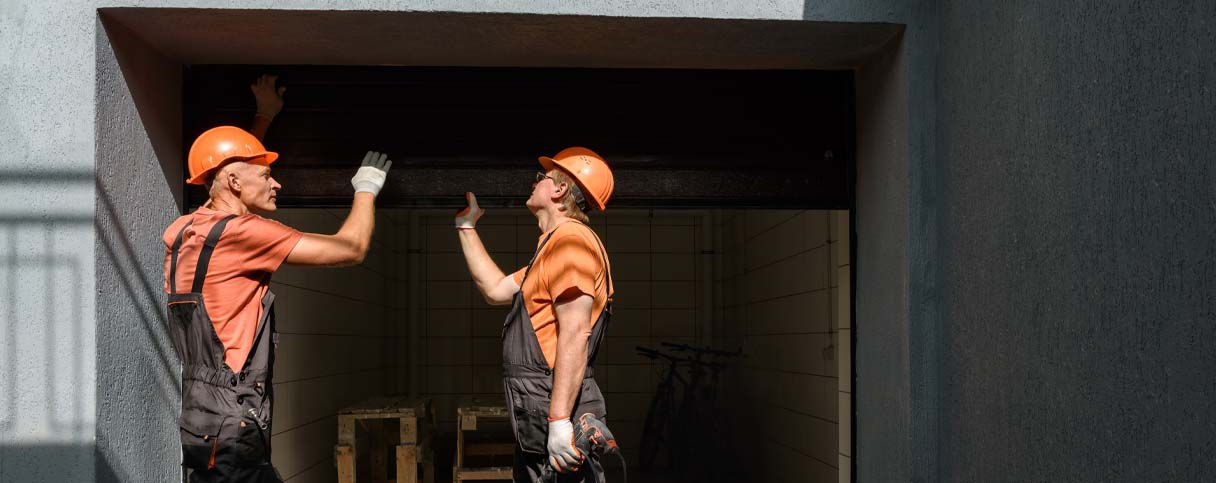
Garage renovation
Renovating a garage: Tips for the garage door, façade and other elements
In spring, a garage has to cope with widely varying temperatures. In summer, the sun heats the roof. In autumn, the wind blows in leaves. And in winter, snow and ice eat away at its fabric. All in all, a garage is constantly exposed to wind and weather just like the rest of your home. To ensure that vehicles, garden tools, food stocks and the like are lastingly protected, it is advisable to check the garage every year and renovate it when necessary. Apart from the damage that can occur over time, it may be necessary to renovate your garage for aesthetic reasons. For example, if the door itself or its colour no longer match the rest of your home, impairing the unified overall look. In the following we provide some tips for renovating your garage door, façade and other elements.
Renovating a garage door
A garage door is often subject to lots of wear and tear, including being opened and closed multiple times a day. It needs to be of high quality in order to cope with all the demands placed on it. Once an ageing garage door has come to the end of its useful life, it’s important that you measure the garage precisely when fitting a new one. The Normstahl dimensioning form provides a good basis for this. Also check that the reveal (the vertical elements at the left and right sides of the opening) and the lintel (the horizontal boundary element along the top) are straight. If they are not, they will need to be corrected. When it comes to the door type, you’re really spoilt for choice. Overhead sectional doors are a practical solution. They allow you to utilise all the space in front of the garage. This type of door also provides the best insulation, and does not require installation of a floor track. If you opt for a one-piece or side sectional door, you’ll need to pay attention to the screeding. Both door types require floor tracks that are ideally embedded in the screed. The tracks can also be installed in the finished floor when renovating, but the first variant will look better. In the case of very old one-piece doors, it’s also possible that the door frame might have been embedded in the garage opening, and has now rusted or been damaged. If so, remove the old frame before installing the new door. There is a general risk of damaging the doorway opening when removing a garage door. Inspect the structure closely, repair any damage, and re-plaster the damaged areas if necessary. We will be glad to provide help and advice through all these steps. Feel free to contact us, or find a local dealer directly.
Renovating the roof
Most garages have a simple flat roof with a very low pitch. The advantage: It saves money. The disadvantage: Damage is more likely to occur, and rain or melt-water will drain off more slowly. This frequently leads to damp spots inside the garage due to roof damage. The flaws are not necessarily directly above the damp spots, because the wind can spread the water widely below the roof seal due to the slight inclination. A professional will quickly be able to locate the weak points. Different methods are recommended depending on your garage’s roof. Plastic profile panels can, for example, be replaced individually. But if you discover damage in a bitumen-coated roof, the panels must either be re-covered or, depending on the damage, the entire roof may need to be replaced. If you wish, you can also add a monopitch roof on top of an existing flat roof. The advantage: You don't have to remove the old roof, and the space in between acts as insulation in winter and a buffer against too much sun in summer.
Repairing the façade
DIY devotees will usually repaint the walls themselves. But take care with this, because where the paint is already peeling the building fabric is directly exposed to weathering. That means rainwater can get in and cause damage – frozen water is especially dangerous in winter. If the plaster is already completely missing in some places, or if the masonry and concrete wall are in poor condition, you must quickly repair and reseal those areas. In such a case, consult an expert in order to prevent major damage to the masonry, or even mould. The final step is to choose the right paint. Don't just think about what colour you want – opt for a high-quality product that is water-repellent and has no diffusion barrier. Why? It’s the only way to protect the masonry from damp, while at the same time quickly dispersing excess moisture.
Renovating the floor
Frost-proof, water-proof and resistant to petrol and oil are just some of the key attributes of a garage floor. Most garage floors nowadays are sealed with an epoxy resin-based coating or tiles. Older floors made of concrete will frequently exhibit damage after a while. If the concrete base is still intact, the floor can be renovated easily. You can repair small cracks and unevenness using a levelling compound. To do this, simply pour the substance onto the concrete floor, spread it with a trowel and let it set. If the concrete floor is already crumbling or washed out, it makes more sense to install a new one. You can then coat or seal it. This will make dirt soiling and abrasion less likely.
Tip: Old garages often have no power supply. So that’s something else to consider when planning a renovation. It will allow you to run power tools or gardening equipment from the garage, and also set you up for installing a garage door operator system. If you are not able to connect a power supply, a solar plant or battery would be sufficient to automatically operate a small door.